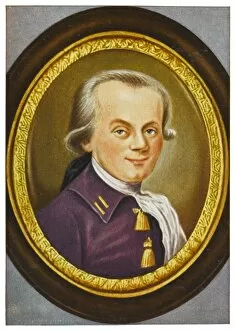Robespierre Collection (#5)
"Robespierre: The Enigmatic Figure of the French Revolution" Maximilien de Robespierre, a prominent figure in the tumultuous era of the French Revolution (1789-1799
For sale as Licensed Images
Choose your image, Select your licence and Download the media
"Robespierre: The Enigmatic Figure of the French Revolution" Maximilien de Robespierre, a prominent figure in the tumultuous era of the French Revolution (1789-1799), left an indelible mark on history. Known for his unwavering commitment to justice and equality, he played a pivotal role in shaping this transformative period. One significant event that showcased Robespierre's determination was the Tennis Court Oath on 20th June 1789. This powerful act symbolized unity among revolutionaries and their resolve to draft a constitution that would grant equal rights to all citizens. As time went on, Robespierre's influence grew within the Committee of Public Safety. His portrait from 1791 depicts him as a man driven by revolutionary ideals, ready to fight for liberty at any cost. However, it was during this time that his radicalism became more apparent. The fall came swiftly when his reign took a dark turn during La Terreur or "The Terror. " In an attempt to safeguard the revolution against counter-revolutionaries, he resorted to extreme measures which led many innocent lives being lost under the guillotine. On the morning of 10th Thermidor Year II, we witness a weakened Robespierre with a fractured jaw spread across a table – an image capturing both physical pain and political defeat. It marked his ultimate downfall as conspirators rose against him in defense of freedom and equality. In July 1794, Maximilian de Robespierre faced execution alongside his fellow supporters at Hotel de Ville de Paris. The engraving depicting this grim moment serves as a haunting reminder of how power can corrupt even those who initially fought for noble causes. Yet amidst controversy and violence surrounding him, there were moments where opposition threatened him directly. Jean Lambert Tallian brandishing a knife towards Robespierre during one such Convention session illustrates just how polarizing his presence was. Robespierre's legacy remains complex and controversial.

















